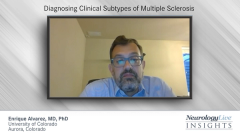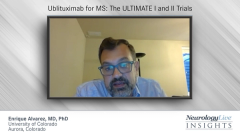
First-Line Treatment Considerations in RRMS
Experts in the management of relapsing/remitting multiple sclerosis provide key insights on the importance of early diagnosis and treatment as well as what factors to consider when selecting therapy.
Episodes in this series

Lawrence Steinman, MD: I initiate therapy on all patients with relapsing/remitting multiple sclerosis [MS], for the simple reason that multiple sclerosis is a terrible disease, and the earlier you intervene, the more likely it is that you’ll have effective control of the disease. I don’t believe in waiting for further bad events to happen. I tell the medical students I teach, “If you could show me any disease where delaying treatment is a benefit, I’ll buy a present for you.” It would be a book. But I’ve yet to have anyone come up with an effective answer to that question. Whether it’s strep throat, where you begin the antibiotic once the diagnosis is made, or something far more serious, like multiple sclerosis or cancer, I don’t wait. I also strongly believe in the principle that if you’re going to give therapy, give strong therapy and give it initially. That’s my attitude. More and more neurologists are coming to this same conclusion, that waiting around and starting with therapies that have less efficacy than some of the modern therapies is not a good idea. My philosophy is to go strong and go early.
Efficacy goes along with trying to shut down the disease as well as possible and as early as possible. Waiting for more events to occur or more lesions to form is not sensible and increases the potential progression of the disease in the individual who should have it shut down as effectively as possible, as soon as possible.
Enrique Alvarez, MD, PhD: As we look at treating patients, especially for relapsing MS, how do we start making decisions for treatment of the patient who’s in front of us in the clinic? This is always a big appointment. One of the mistakes we sometimes make is not recognizing that it might be a lot of information for the patient. Breaking up some of these appointments is helpful. It’s helpful to do the follow-up in a week or two to answer questions and have those discussions with the patient.
It’s important nowadays to include a bit of a discussion around treatment philosophies. The idea of using either escalation or high efficacy early becomes important, because we have so many different drugs that it starts to help identify what direction a patient may want to go. Bringing up this concept helps narrow the scope of which drugs you may or may not cover. It’s reasonable to start asking the patient whether they’re willing to do shots. If they’re not willing to do shots, then spending a lot of time on the injectables may not make a lot of sense. Asking them if they’re willing to take a medicine 2 times a day vs 1 time a day as a pill may help narrow some of the options. You get a little of this background information, and then you can start having a discussion with the patient.
I’ve seen a few mistakes that come up in the process of making an informed decision with a patient. I’ve seen patients come into my office with 4 brochures for different drugs, and the provider said, “Go home, read about them, and then pick 1.” I would strongly urge against that. It’s important to guide the patient in these decisions, then go through these decisions. Having a personalized approach becomes important.
We are known for treating MS early with high efficacy therapies. It’s a reminder for us that sometimes, even though we might have a bias, that may not be shared by the patient. It’s important to have that discussion. Along with the treatment frequency, it’s important to think about how often to monitor. Let’s look at alemtuzumab, for example. It’s great. You do 5 days of treatment, and then you’re done for a year. That’s often how we sell it. But it’s realizing that you’re having to do monthly laboratory work for 4 years after that second year treatment of 3 days. The patient’s not going to forget they had a treatment if they’re having to come in every month for a blood draw, for example. There are convenience and tolerability issues associated with different medicines that help make some of these decisions.
There’s also a concern about risk vs perceived risk. There’s an idea that if you get a medicine via an infusion, it must have more risks than pills, for example. Not that we use chemotherapy in MS, but for example, a lot of chemotherapy is just pills and has a lot of risk associated with it. It’s helpful to present what the risks are, and deal with perceived risk, and provide reassurance that some of the infusible medications, especially for certain patient populations, might actually be safer than medications that come via an IV [intravenous] route. You put all of these decisions together, offer the information for the patient, and make a decision with them. That is really important.
Transcript Edited for Clarity
Newsletter
Keep your finger on the pulse of neurology—subscribe to NeurologyLive for expert interviews, new data, and breakthrough treatment updates.







































